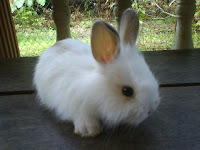1.
jj Nesting For New Borns..
1. Designate a nesting area for the newborn bunnies. This may
be indoors or outdoors depending on the season and climate. Baby bunnies must
stay warm so they don't burn too many calories. Babies also need to stay dry.
Make sure any outdoor nesting area is away from the elements.
o
2
Set up the bunnies' nesting box. A
nesting box can be made with a wooden or cardboard box or a cat litter box.
Layer the bottom of the nesting area with towels. Using a bunched up towel on
top will give the bunnies a place to snuggle. Nesting wool, found in pet
stores, can also be used on top of the towels. Keep babies in the dark by
covering the box with another towel. Confirm that enough air is circulating in
the nesting area to keep the bunnies from suffocating.
o
3
Check the temperature of the nesting
box location. Whether indoors or outdoors, the ideal temperature is 68 to 72
degrees F. If cooler, you may want to place a heating pad on low under one-half
of the towel, providing the babies a warm and cool place to rest.
o
4
Separate the mother bunny, if
applicable, if she appears to be neglecting the babies. She may hurt the baby
bunnies if left in the same nesting box. Neglect can be determined by
evaluating the bunnies' health and appearance. A mother rabbit taking proper
care of her young will supply them all the necessary food in their first two
weeks of life. You must feed the babies no more than twice a day if they don't
have a mother or are lacking proper care from a mother.
o
5
Prepare the baby bunnies for feeding
by placing them in hand towels and laying them on your lap. They should be on
their backs for feeding to mimic how they feed from their mother.
o
6
Determine how much food the bunnies
need according to age. Use an eye dropper to feed the bunnies Kitten Milk
Replacer, available at pet stores and some veterinarian offices. Add a
tablespoon of cream to mimic the calorie count of rabbit milk. Buy acidophilus
from a health food store in capsule form, and add it to the KMR for feeding.
This combination gives your bunnies the best survival rate due to its ability
to maintain the babies' stomach bacterial balance. Newborns should receive 5cc
of KMR and one-half cc (one-half of a capsule) of acidophilus each day. At
one-week, increase the bunnies' intake to 10 to 15 cc.
o
7
Use a wet cotton ball to stimulate
the mother rabbit's behavior by wiping the bunnies between their front legs
towards their anal area. This encourages them to go to the bathroom, which
helps keep their digestive tracks in order.
o
8
Clean the nest box and the newborn
bunnies daily. It is important to remove any wetness from the nest box. Wipe
any milk excess from the bunnies' mouths and hair.
o
9
Offer hay and rabbit pellets to baby
bunnies over 10 days old whose eyes have opened. Use a shallow dish for
drinking water so that the bunnies can't drown.
o
10
Keep newborn baby bunnies away from
predators and other rabbits that may harm them.









